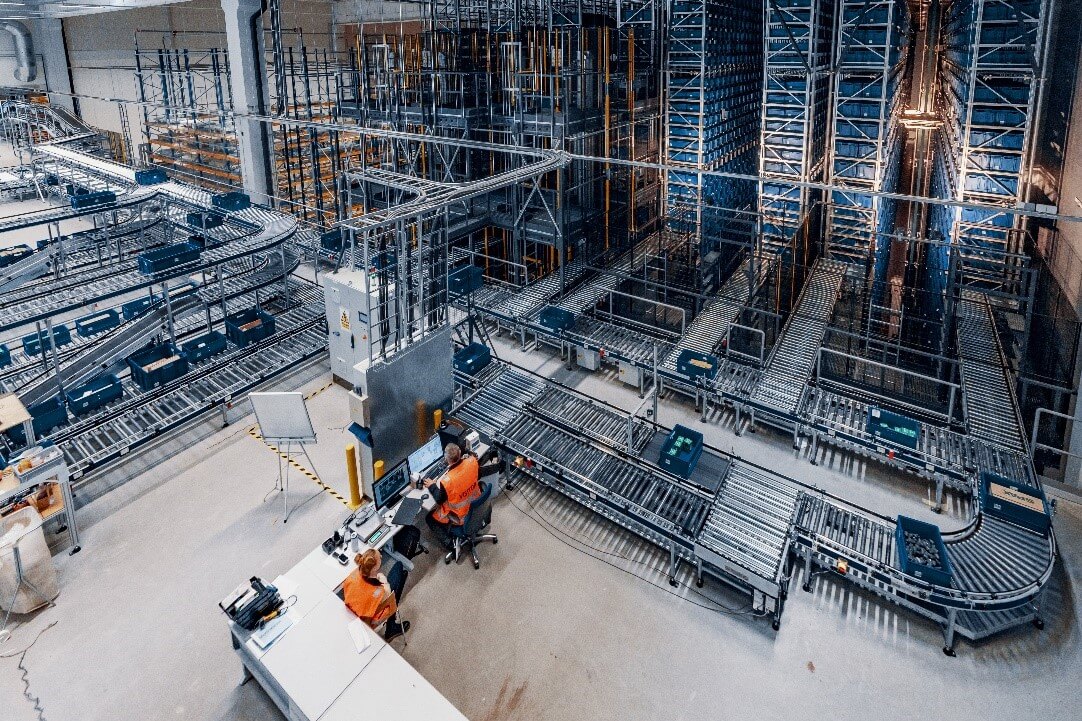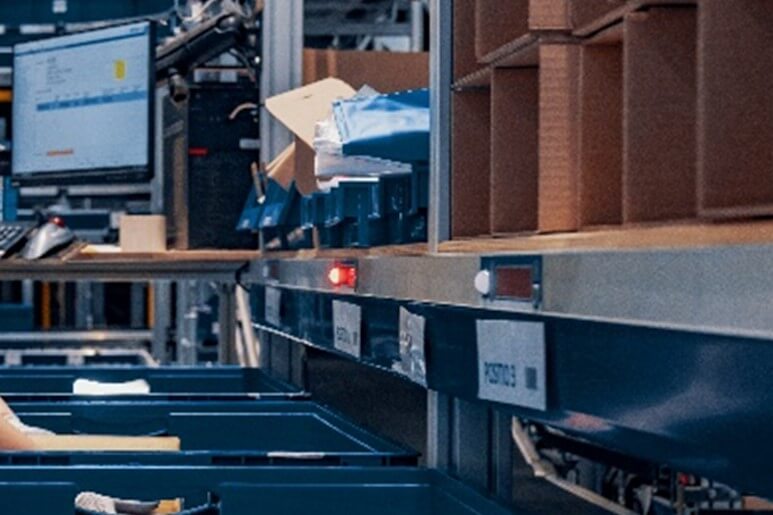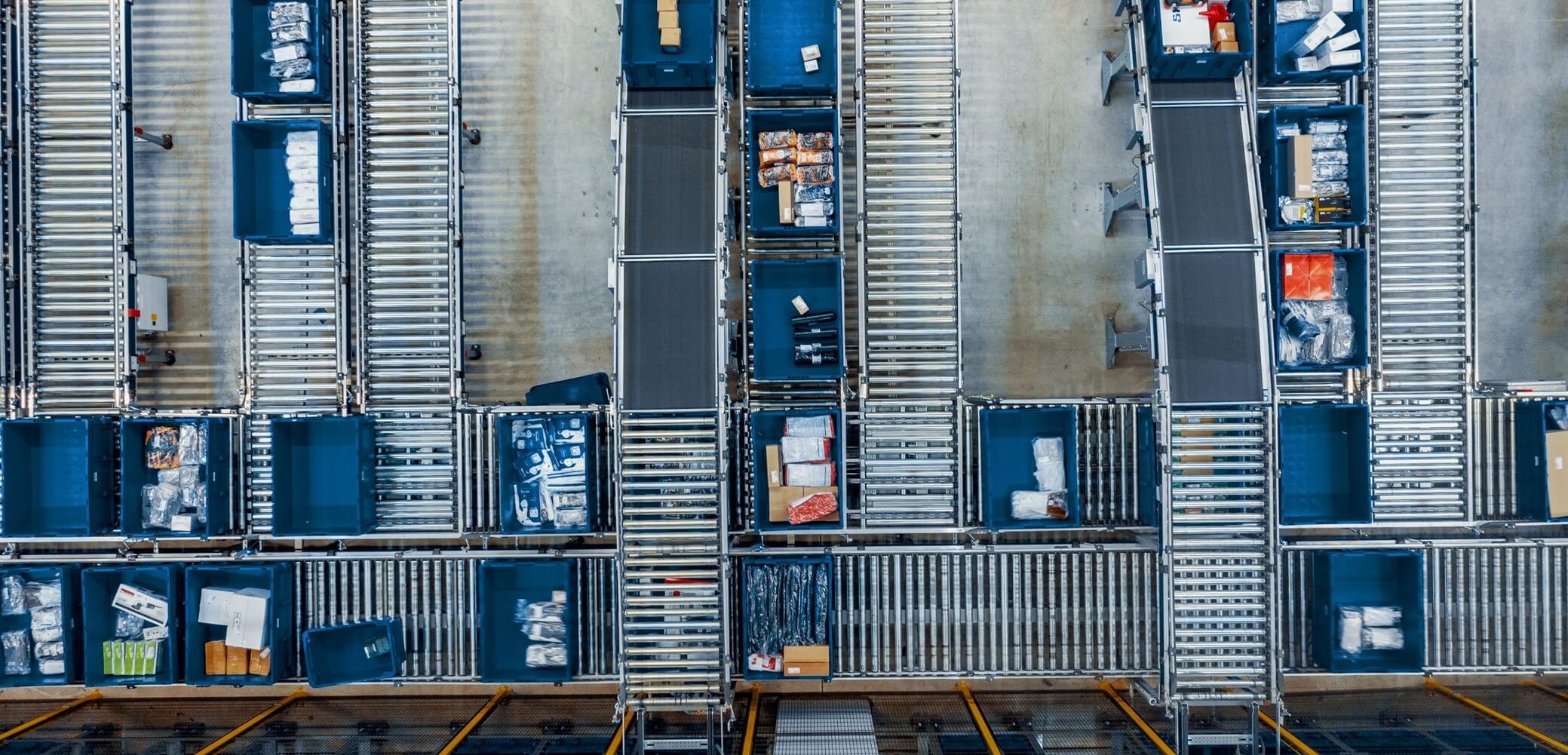Higher, faster, further! Customer demands on the Finnish technology company ETRA Oy (ETRA), which offers its customers a wide range of industrial products and services as a wholesaler and retailer, are constantly increasing and require the highest level of quality and reliability at all times. Looking to the future, ETRA has therefore made a conscious decision in favor of automation when expanding its warehouse logistics at the Hämeenlinna (Finland) central warehouse site.
With the expansion of the logistics center and the implementation of the WMS (Warehouse Management Software) SuPCIS-L8, ETRA has already taken decisive steps into the digital age. The processes that the WMS SuPCIS-L8 maps and supports include all processes and components in the automated warehouse areas, from goods receipt to picking with integrated pick-to-light system and consolidation to packaging. Thanks to the seamless interaction of the WMS and MFC with the system controls of Gebhardt Fördertechnik GmbH, ETRA benefits from a customized and efficient material flow.
The new, double-deep 4-aisle mini-load warehouse (automated small parts warehouse) offers an extensive usable area and around 50,000 storage locations for the wide range of warehouse products. Incoming goods from the central goods receiving area or replenishment from the manual storage areas are repacked onto the containers automated and provided by the WMS in the quantity suggested by the WMS, depending on the quantity and configuration in the WMS article master. Two different types of totes are available for this purpose. If required, these can also be subdivided for the storage of several articles per container. This subdivision is also visualized graphically in the processes. Before the goods can be stored, however, they are subjected to a weight and height check. In this context, the specified maximum weight of 50 kg is also checked and it is ensured that no material or packaging material is protruding from the containers.

In the event of a fault, the containers are returned directly to the operator with the fault displayed. For very small quantities, one of the repacking stations also offers the option of requesting low-filled storage containers for storage.
Of the four aisles of the miniload, two are operated by RGBs (storage and retrieval machines) from Gebhardt Fördertechnik and serve as a zone for non-fast-moving goods with large stock. In the other two aisles, totes with fast-moving items are stored. Five MLSs (multi-level shuttles) arranged on top of each other operate there and are supplied and discharged via a lift. This parallelization significantly increases storage performance. Each individual vehicle, as well as the three controllers of the conveyor areas, are directly coupled to the SuPCIS-L8 MFC.
In order to also increase performance during storage, the SRM and the MLS have the option of transporting two containers at the same time. The selection of storage locations is optimized by the WMS to take into account both the current occupancy of the buffers in front of the levels and the storage location occupancy within the aisles, as well as pair formation for double-deep storage.
Fast and transparent logistics processes
The WMS manages both the new miniload and the previously installed picking and storage area with 32 Kardex storage towers and upstream Gebhardt conveyor technology. Here, the WMS latched into the interface that originally existed between the Kardex control system and the host just as it did between Kardex and the existing conveyor control system. The new functionality could thus be achieved without interfering with the existing systems. If goods from both areas are required within an order, the goods are first picked in the Kardex area and temporarily stored in the consolidation buffer, which is also automated by means of a multi-level shuttle. Only then does the WMS start removing the order parts from the miniload.
The conveyor system then takes the individual source totes to the six "goods-to-person" picking workstations, each with four destination stations for extra-large totes that are only used for transport between the picking station and the packing station. These totes are provided automatically and married to the destination bin. Here, the WMS schedules large orders to individual totes and single-item orders to reduce transports on the conveyor system between the picking and packing area to collective totes. The employee is shown the product image and picks the goods in the quantity specified by the WMS. The attached pick-to-light system makes the subsequent distribution process even easier for the employees, as the display mounted above the container shows the employee where which quantity has to be placed. Afterwards, the distribution only has to be confirmed via the acknowledgement button.
For small items that would have to be counted in large quantities, counting scales fully integrated in the SuPCIS L8 dialog are used. The dialog ergonomically shows in each case how many articles have been weighed and to what extent further piece goods still have to be added or removed. Time-consuming counting is no longer necessary thanks to the integrated dialog. The scales do not have to be operated additionally in the WMS.

Once an order has been completed, this is indicated to the employee in plain text via the PTL system. The employee triggers the removal of the target container via the display, as well as the removal of the source container when it is no longer required. By the time the employee is back at the extraction point, the next extraction container has already been prepared. Depending on requirements, the source container either moves to another picking station or is returned to the miniload after a zero cycle.
Order totes that contain a complete order, like the consolidation totes for single-item orders, arrive at one of the six packing stations via a loop directly after the picking process. If, on the other hand, an order is made up of several totes that come from both automated storage areas, intermediate buffering first takes place until the last tote arrives at the consolidation buffer. The WMS then initiates the retrieval of all containers belonging to an order to one of the five packing stations directly controlled from the consolidation buffer in the priority controlled by the operator.
This is very important, as both direct deliveries to customers' construction sites and replenishment orders to the decentralized warehouses and ETRA sales outlets throughout Finland are made with different departure times from the central warehouse. ETRA's high quality of service requires that all orders are delivered ready on the day. Parcel deliveries are packed and prepared for shipment at the packing station. Deliveries to ETRA outlets are made in an environmentally friendly manner via a recirculation system with reusable containers, which the packer transfers back to the conveyor system and are discharged fully automatically via staging lanes.
Complete overview of the condition in the warehouse

In order to increase efficiency, productivity and transparency in ETRA's warehouse as best as possible and to avoid errors, the photo studio in SuPCIS-L8 and the Warehouse Viewer are also used. With the photo studio in SuPCIS-L8, the articles or packaging units can be captured pictorially via the camera in the MDE, which previously had no image stored in the web store. Using the integrated image processing, special features can also be marked, displayed in the warehouse management system and permanently stored.

In addition, the Warehouse Viewer provides a graphical overview of the warehouse areas at any time as well as a visualization of the movements and states of the automation components used in the warehouse. This also makes it possible to view possible malfunctions in the warehouse or scanner statistics quickly and easily at any workstation of the WMS. The SuPCIS-L8 Cockpit with its collection of dashboards displays current data on the number of pending and closed orders, information on the current fill level of the aisles, storage and retrieval, and the status of picking.
Efficient logistics strategy as the linchpin of the future
The smooth interaction between the WMS SuPCIS-L8 and the conveyor technology from Gebhardt form a successful overall solution for the company. Due to the flexibility, customizability and available interfaces of the warehouse management software, ETRA will also have the opportunity to further expand its warehouse logistics in the future. "Through the expansion of our warehouse logistics and the successful implementation of SuPCIS-L8, we will also be able to best meet the needs of our customers in the future. The structured warehouse and work processes as well as the increased efficiency, transparency and flexibility in our warehouse allow us to look positively into the future," says Pekka Pöntiö, Head of Logistics at ETRA.
"We are delighted with the trust placed in us by ETRA and Gebhardt and still fondly remember this joint team achievement, which was of course celebrated on site in typical Finnish style in the sauna," says Horst Reichert, Managing Director at S&P Computersysteme GmbH.


%402x.svg)



